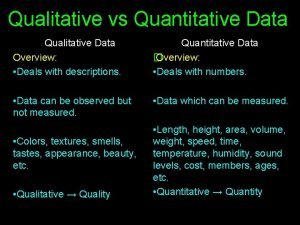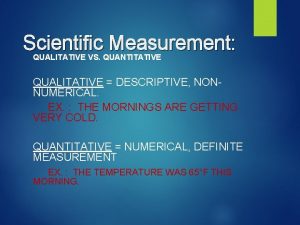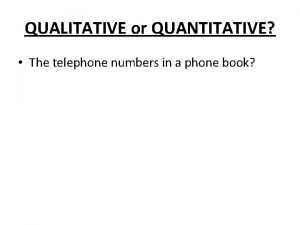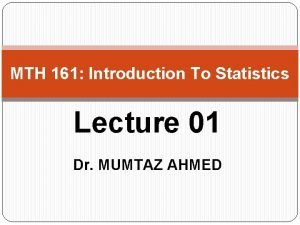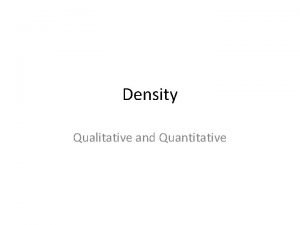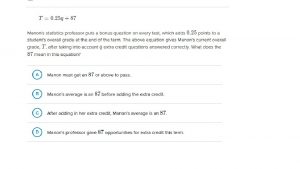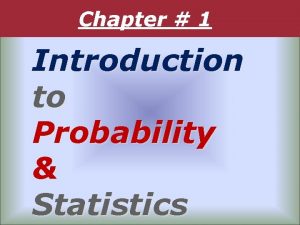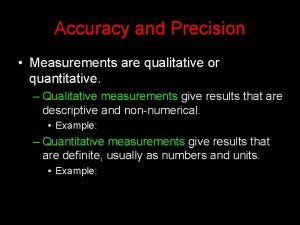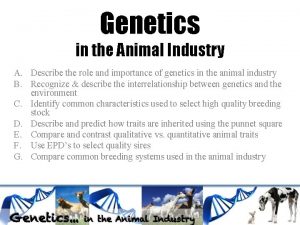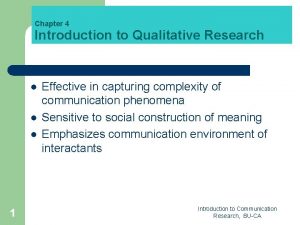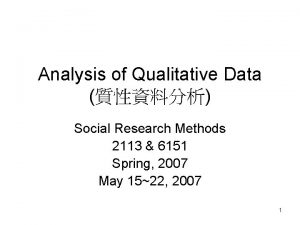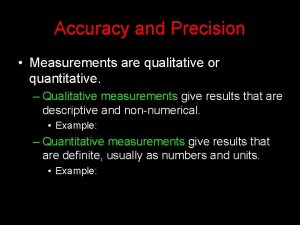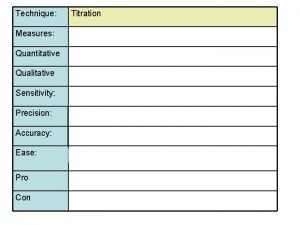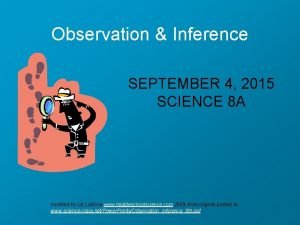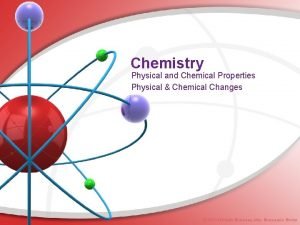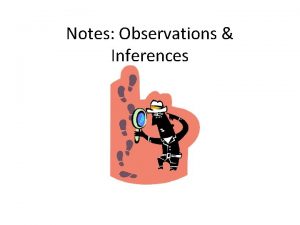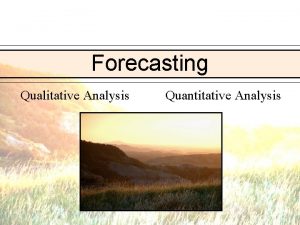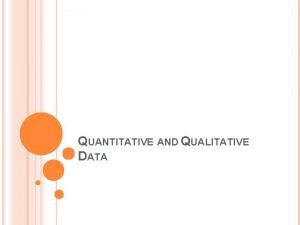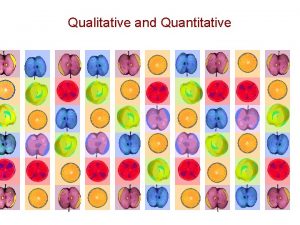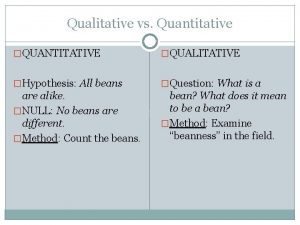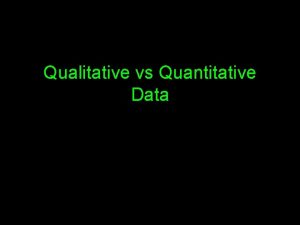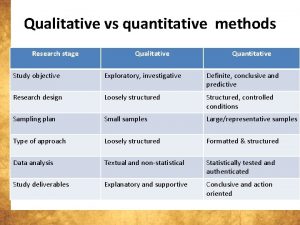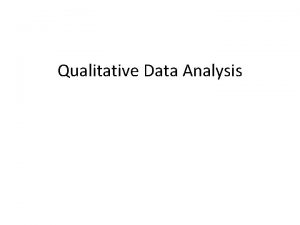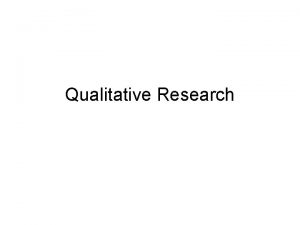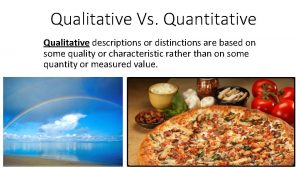FORECASTING Qualitative Analysis Quantitative Analysis Predictions or Forecasting



































- Slides: 35

FORECASTING Qualitative Analysis ~ Quantitative Analysis

Predictions or Forecasting with: -Multiple Regression -Confidence Interval for Prediction -Trend Analysis and Projections -Seasonal Models -Smoothing Techniques

Qualitative Analysis -Surveys -Polling -Expert Opinion (Personal Insight) -Panel Consensus -Delphi method • using forecasts derived from independent analysis of expert opinion

Forecasting with Multiple Regression Confidence intervals for prediction. y = b + bx + u t 0 1 - Suppose that 1 t 2 2 t 3 3 t 4 4 t t = 10 – 0. 5 x + 0. 25 x + 0. 3 x + 0. 6 x 1 t - Provide a forecast for y 2 t 3 t 4 t t+1 - To do so, we need future values of x , x , and x 1 t 2 t 3 t 4 t Suppose that: x = 12 x = 10 x =5 x =2 Then y = 10 – (0. 5)(12) + 0. 25(10) + 0. 3(5) + 0. 6(2) y = 10 – 6 + 2. 5 + 1. 2 y = 9. 2 1 t+1 2 t+1 3 t+1 4 t+1 t+1 The forecast is conditional upon future values of x , x , and x. 1 t This forecast is a point forecast 2 t 3 t 4 t

Confidence Interval for Prediction (or Forecast) with Multiple Regression This confidence interval is given by: point forecast ± se(regression) * critical value c se(regression) = critical value c: t , α n-p Suppose that se(regression) = 2. 4 and that t , α = 0. 05 = 1. 8 n-5 With our point forecast of 9. 2, then the 95% confidence interval for prediction is given by: 9. 2 ± (2. 4)(1. 8) 9. 2 ± 4. 32 [4. 88, 13. 52]

In general, any time series may be decomposed into four components: 1. trend component 2. seasonal component 3. cyclical component 4. random component

Time-Series Analysis of Forecasting Develop models to stress trend component, seasonal component, and cyclical components. -trend analysis and projection -seasonal models -smoothing techniques (cyclical components) • Moving Average Models • Autoregressive Models

Trend Analysis and Projections Trend Analysis - forecast the future path of economic variables based on historical data - use a regression model to model the trend as a function of time Types of trend analysis - linear trend - nonlinear trend - seasonal variations

Time-Series Characteristics: Secular Trend and Cyclical Variation in Women’s Clothing Sales

Time-Series Characteristics: Seasonal Pattern and Random Fluctuations

Linear Trend y : variable of interest t t: time, t = 1, 2, …, T ß : intercept Questions: ß : slope, a constant change in the series from one period to the next period -Does a linear trend have any curvature? 0 1 -How to interpret ß ? 0 -If ß > 0, what does it mean? 1 -If ß < 0, what does is mean? 1

Linear Trend Line: Example Proposed model: S = a + b + ε t t t -Microsoft annual sales revenue (1984 – 2001) link to spreadsheet * S = annual sales revenue * t = time period * a = sales revenue at t = 0 (may or may not be meaningful) * b = series grows ( if b > 0) or declines (if b < 0) by a constant amount -How to conduct a linear trend analysis? * create another column for t * conduct an OLS regression -Estimation results: -Question: Note: St = -6, 440. 8 + 1, 407. 3 t (1850. 96) (171. 00) * What is the sales revenue at t = 0? * interpret The series grows by $1, 407. 30 dollars each year over the period 1984 to 2001.

Linear Trend of Microsoft Corp. Sales Revenue, 1984 -2001

Key Issue: Forecasting Annual Sales Revenue from 2002 -2010 Year t Predicted Sales 2002 19 -6, 440. 8 + 1, 407. 3(19) = 20, 298. 7 2003 20 -6, 440. 8 + 1, 407. 3(20) = 21, 706. 1 2004 21 -6, 440. 8 + 1, 407. 3(21) = 23, 113. 4 2005 22 -6, 440. 8 + 1, 407. 3(22) = 24, 520. 8 2006 23 -6, 440. 8 + 1, 407. 3(23) = 25, 928. 1 2007 24 -6, 440. 8 + 1, 407. 3(24) = 27, 335. 5 2008 25 -6, 440. 8 + 1, 407. 3(25) = 28, 742. 8 2009 26 -6, 440. 8 + 1, 407. 3(26) = 30, 150. 1 2010 27 -6, 440. 8 + 1, 407. 3(27) = 31, 557. 5

Non-Linear Trend: Quadratic Trend y : variable of interest t t: time, t = 1, 2, …, T ß : intercept Questions: Marginal increase from this period to the next one: - Does a quadratic trend have any curvature? 0 - How does the series grow (or decline) each period? Calculate on t. Note: this growth or decline depends

Non-Linear Trend Line (Quadratic Trend): Example - Proposed Model: - Microsoft annual sales revenue (1984 -2001) link to data * S = annual sales revenue * t = time period * a = sales revenue at t = 0 (may or may not be meaningful) * b and b : trend parameters 1 2 - How to approach? * create two additional columns * conduct an OLS regression - Estimation Results S = 2628. 7 – 1313. 5 t + 143. 2 t² (786. 1) (190. 5) (9. 7) Standard errors in parentheses - Question: R² = 0. 9876, = 0. 9860, n = 18 * What is the sales revenue at t = 0? * Calculate = -1313. 5 + 286. 4 t

Non-Linear Trend – Quadratic Trend of Microsoft Corp. Sales Revenue, 1984 -2001

Key Issue: Forecasting Annual Sales Revenue from 2002 to 2010 Year t t² Predicted Sales 2002 19 361 2628. 7 – 1313. 5(19) + 143. 2(19)² = 29, 368. 19 2003 20 400 2628. 7 – 1313. 5(20) + 143. 2(20)² = 33, 639. 57 2004 21 444 2628. 7 – 1313. 5(21) + 143. 2(21)² = 38, 197. 35 2005 22 484 2628. 7 – 1313. 5(22) + 143. 2(22)² = 43, 041. 54 2006 23 529 2628. 7 – 1313. 5(23) + 143. 2(23)² = 48, 172. 13 2007 24 625 2628. 7 – 1313. 5(24) + 143. 2(24)² = 53, 589. 12 2008 25 625 2628. 7 – 1313. 5(25) + 143. 2(25)² = 59, 292. 52 2009 26 676 2628. 7 – 1313. 5(26) + 143. 2(26)² = 65, 282. 32 2010 27 729 2628. 7 – 1313. 5(27) + 143. 2(27)² = 71, 558. 52

Exponential Trend y : variable of interest t t: time, t = 1, 2, …, T Questions: ß : intercept 0 The series grows (if ß > 0) or declines (if ß < 0) by a constant percentage. 1 1 - Does an exponential trend have any curvature? - If ß > 0, what does this finding mean? 1 - If ß < 0, what does this finding mean? 1

Exponential Trend Line: Example Proposed model: Regression model: link to data Microsoft annual sales revenue (1984 -2001) - S = annual sales revenue - t = time period - estimation of α: How to approach? - create two additional columns *Log(S 1) = log(sales revenue) * t for time period Estimation results Questions: - What is the sales revenue at t = 0? - By what constant percentage does sales revenue grow? The series grows by 33. 6% each year.

Exponential Trend of Microsoft Corp. Sales Revenue, 1984 -2001

Key Issue: Forecasting Annual Sales Revenue from 2002 -2010 Exponential Trend S = 96. 38*exp(0. 336 t) t Year t Predicted Sales 2002 19 96. 38*exp(0. 336*19) = 57, 182. 8 2003 20 96. 38*exp(0. 336*20) = 80, 026. 6 2004 21 96. 38*exp(0. 336*21) = 111, 996. 0 2005 22 96. 38*exp(0. 336*22) = 156, 736. 9 2006 23 96. 38*exp(0. 336*23) = 219, 351. 1 2007 24 96. 38*exp(0. 336*24) = 306, 978. 8 2008 25 96. 38*exp(0. 336*25) = 429, 612. 5 2009 26 96. 38*exp(0. 336*26) = 601, 236. 6 2010 27 96. 38*exp(0. 336*27) = 841, 422. 2

Seasonal Variation Common Examples: - Christmas shopping rush - seasonal products and activities (Halloween candy, Thanksgiving turkey) - weekends vs. weekdays - sports seasons and events - political elections

Seasonal Variation continued. . . Use of indicator variables or dummy variables. A dummy variable equals one when a condition is met and it equals zero otherwise. - Example: Define quarterly dummy variables as follows:

Seasonal Variation continued. . . - Run a regression with dummy variables to account for seasonality. - Note: You must leave out one of the dummy variables! Why? Perfect collinearity Which one to drop? It doesn’t matter. It will not change your R² or F statistic, coefficient estimates, or their tstatistics. How to interpret? The dummy variable left our becomes the base case. The estimated dummy coefficients are adjustments relative to this base case. - In a comparison with the fourth quarter (D 4 is the base), sales change by c 1 in the first quarter, c 2 in the second quarter, and c 3 in the third quarter.

Seasonal Dummy: Example Quarterly Temperature Readings in a Resort City Over the Period 1994 to 2004 Quarter 1: Jan. – March Note the Regular Periodicities of the Temperature Data Quarter 2: April – June Year Quarter Temperature Quarter 3: Jul. – Sept. 1994 1 47 Quarter 4: Oct. – Dec. 1994 2 65 1994 3 83 1994 4 67 1995 1 51 1995 2 64 1995 3 82 1995 4 66 . . 2004 1 48 2004 2 67 2004 3 80 2004 4 67

Seasonal Dummies: Example continued. . . Define dummy variables: Regression Model: - Why is the 4 th quarter (D ) omitted? (Base Case) 4 - Does it matter if we use another base? (No)

Seasonal Dummies: Example continued. . . Regression Results: (0. 48) (0. 68) n² = 0. 9841 (0. 68) R² = 0. 9829, n = 44

Key Issue: Forecasting Quarterly Temperature in a Resort City for 2005 and 2006 Year Quarter Predicted Temperature 2005 1 66. 54 – 17. 64 = 48. 90 ≈ 49 2005 2 66. 54 – 1. 45 = 65. 09 ≈ 65 2005 3 66. 54 + 16. 27 = 82. 81 ≈ 83 2005 4 66. 54 2006 1 66. 54 – 17. 64 = 48. 90 ≈ 49 2006 2 66. 54 – 1. 45 = 65. 09 ≈ 65 2006 3 66. 54+ 16. 27 = 82. 81 ≈ 83 2006 4 66. 54 ≈ 67

Smoothing Techniques - Take into account cyclical components in a time-series. - Smoothing Techniques: Moving Average model Autoregressive model

Moving Average (MA) Forecasts - N-period MA forecasts the next period as the average of the last N periods: - 3 -month MA projection of sales for March is average sales in Feb. , Jan. , and Dec. - The longer the MA, the greater the smoothing: a 5 -month MA is smoother than a 3 -month MA - Use a longer MA when random fluctuations are a larger component of the time series. - Use RMSE and MAD to decide upon the appropriate smoothing time frame. RMSE = root mean square error MAD = mean absolute deviation

Moving Average: Example Month Observed S 1 1100 2 1891 3 4 5 6 7 8 9 10 11 12 1769 1897 1798 2168 2364 2554 3387 2079 2890 2690 2 month MA 1495. 5 1830 1833 1847. 5 1983 2266 2459 2970. 5 2733 2484. 5 Sq Err 2 MA Abs Err 2 MA 74802. 25 4489 1225 102720. 25 145161 82944 861184 794772. 25 24649 42230. 25 273. 5 67 35 320. 5 381 288 928 891. 5 157 205. 5 RMSE 462. 0 3 month MA 1586. 67 1852. 33 1821. 33 1954. 33 2110. 00 2362. 00 2768. 33 2673. 33 2785. 33 Sq Err 3 MA Abs Err 3 MA 96306. 78 2952. 11 120177. 78 167826. 78 197136. 00 1050625. 00 475180. 44 46944. 44 9088. 44 310. 33 54. 33 346. 67 409. 67 444. 00 1025. 00 689. 33 216. 67 95. 33 MAD RMSE MADMAD 354. 7 490. 6 399. 04 In this case, choose 2 mo. MA over 3 mo. MA

Autoregressive (AR) Model - Time-series approach, univariate model - Autoregressive model of order 1: AR(1) - Autoregressive model of order p: AR(p) - How to approach? OLS regressions

Autoregressive Model: AR(2) Create two variables, S and S t-1 Run an OLS regression t-2 link for data - data: Months 3 -12 Arrange the following values for each observation: - actual sales - predicted sales - square of error Calculate RMSE or MAD - RMSE = 387. 07 - MAD = 288. 62

Which Model is Better, MA(2), MA(3), or AR(2)? The one with the lowest RMSE or MAD. MA(2) MA(3) AR(2) RMSE 462. 0 490. 6 387. 07 MAD 399. 04 288. 62 354. 7 AR(2) is the preferred model.
 Ualitative data
Ualitative data Example of quantitative data
Example of quantitative data Qualitative vs quantitative data analysis
Qualitative vs quantitative data analysis Hypothesis template
Hypothesis template What is qualitative data in geography
What is qualitative data in geography What is holistic approach in qualitative research
What is holistic approach in qualitative research Longitudinal study qualitative or quantitative
Longitudinal study qualitative or quantitative Qualitative vs quantitative measurements
Qualitative vs quantitative measurements Qualitative data in biology
Qualitative data in biology Are telephone numbers qualitative or quantitative
Are telephone numbers qualitative or quantitative Qualitative vs quantitative
Qualitative vs quantitative Quantitative and qualitative data difference
Quantitative and qualitative data difference Definition of qualitative and quantitative observations
Definition of qualitative and quantitative observations Needs assessment research method
Needs assessment research method Quantitative variables examples
Quantitative variables examples Differenzierungsmaßnahmen
Differenzierungsmaßnahmen Density
Density Qualitative vs quantitative sociology
Qualitative vs quantitative sociology In a survey of 177 237 u.s. adults
In a survey of 177 237 u.s. adults Quantitative and qualitative variables examples
Quantitative and qualitative variables examples Precision of measurement depends on *
Precision of measurement depends on * Words images objects qualitative or quantitative
Words images objects qualitative or quantitative Quantitative traits
Quantitative traits Qualitative traits vs quantitative traits
Qualitative traits vs quantitative traits Qualitative and quantitative test for lipids
Qualitative and quantitative test for lipids Examples of qualitative and quantitative observations
Examples of qualitative and quantitative observations Similarities between qualitative and quantitative research
Similarities between qualitative and quantitative research Qualitative traits vs quantitative traits
Qualitative traits vs quantitative traits Similarities between qualitative and quantitative research
Similarities between qualitative and quantitative research Qualitative data quantitative data
Qualitative data quantitative data Is accuracy qualitative or quantitative
Is accuracy qualitative or quantitative Is titration qualitative or quantitative
Is titration qualitative or quantitative The grass is wet observation or inference
The grass is wet observation or inference Qualitative properties of matter
Qualitative properties of matter Qualitative research methods
Qualitative research methods The candy was sour is that qualitative or quantitative
The candy was sour is that qualitative or quantitative

